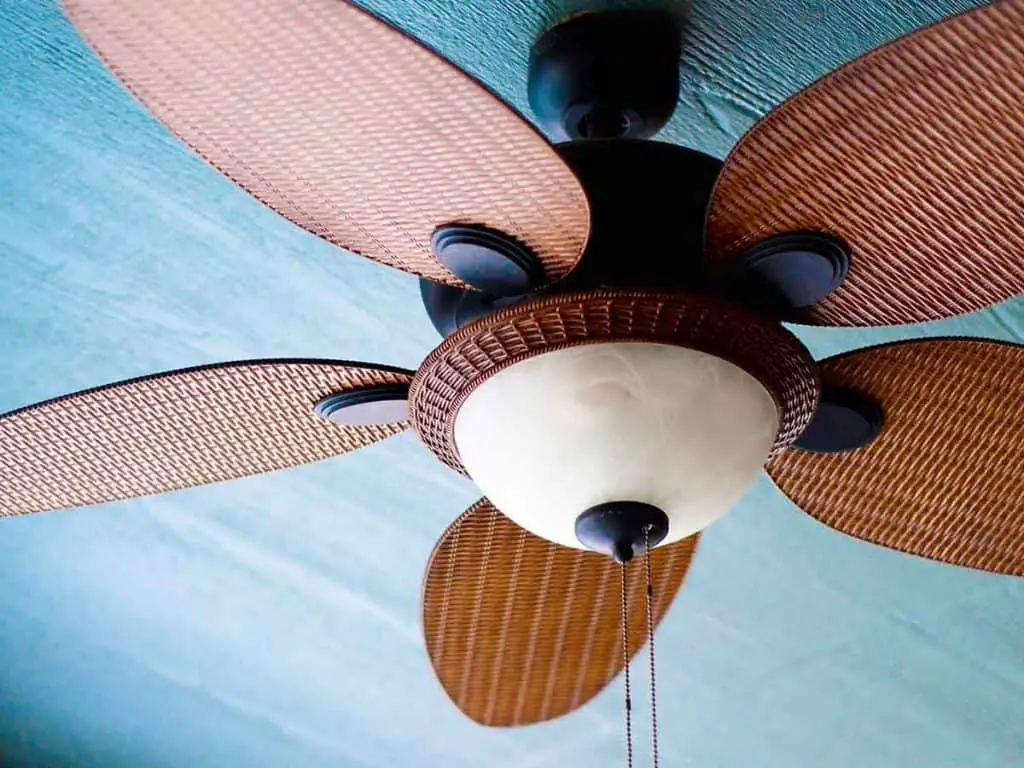Ceiling Fan Direction: Optimal Settings (All 4 Seasons)
A ceiling fan keeps you cooler in Summer and warmer in Winter, but you need to pay attention to the ceiling fan direction.
Strategic seasonal changes to your ceiling fan direction will save you money and improve your comfort levels.

Does Ceiling Fan Direction Really Matter?
A ceiling fan rotating in an anticlockwise direction pushes air downwards – a great way to cool down during the Summer months. Conversely, a ceiling fan spinning in a clockwise direction pulls the air upwards, effectively recirculating heat to increase comfort in the Winter.
The ceiling fan direction changes the way air moves around your room.
The natural movement of air involves warm air rising and cold air sinking. This property of air is responsible for most of the weather on Earth.
The air movement in your living room is on a smaller scale and has less dramatic consequences, but it can impact your comfort levels.
Without a ceiling fan, your hot air rises to the ceiling, and cold air sinks to the floor. The ceiling fan redistributes the air in your room differently from the natural movement of air.

How to Set Ceiling Fan Direction for Summer Months?
In Summer, you want to cool down, and the best ceiling fan direction in Summer is anticlockwise, so the air at the top of the room flows downwards.
This direction may seem counterintuitive, but it works.
Ceiling Fan Direction in Summer with Air Conditioning
If you are running air conditioning and your ceiling fan, then the ceiling fan will move the cold air down to the bottom of the room quicker than the natural sinking of cold air.
This process benefits you by giving you the benefit of the cold air in a shorter time frame, allowing you to switch off or reduce your air conditioning.
Using less of your air conditioning saves you money.
You can gain savings of 40% with the ceiling fan running in the anticlockwise direction compared with using air conditioning in the Summer without a fan.
Airflow is Cooling
With or without air conditioning, changing the Summer fan direction to anticlockwise in warmer months gives you the benefit of airflow.
Airflow across your skin is cooling because it enables moisture on the skin to evaporate. Water changing from liquid to gas removes heat from your skin with a strong cooling effect.
Plus, your skin is the body’s organ that absorbs and radiates heat to try to maintain an even body temperature.
Air flowing across the skin pushes away the warm air around your body – the cooling effect is known as wind chill.
The windchill effect can make a room feel a good eight degrees cooler than the same room without air movement.
The best ceiling fan speed in Summer is the fastest setting for the most significant wind chill effect.
Check Ceiling Fan Direction for Summer
Do you know how to tell the ceiling fan direction is rotating in an anticlockwise direction?
The best ways are:
- Watch the fan blades spinning at low speed – focus on one blade, and it should move in the opposite direction to the hands of a clock – from bottom left to right and then up to the top.
- Feel the downdraft – If you can’t feel the downdraft when you stand under a ceiling fan rotating in an anticlockwise direction, you probably need to upgrade your fan. To be effective, you must feel the movement of air when your ceiling fan is running.
- Blow some soap bubbles – lighter than air; soap bubbles will move where the airflow takes them. If they move towards the floor, you know your ceiling fan rotates in a counterclockwise direction and moves air down.
How to Change Your Ceiling Fan Direction for Summer?
The older models of ceiling fans have a toggle switch on the motor’s side that slides up and down or left to right.
To change direction, slide the toggle to the opposite side.
More recent ceiling fan models have the better option of a reverse ceiling fan by remote control or a wall panel, so you easily adjust your settings for direction and speed.
When in Summer Should You Set Your Ceiling Fan to Winter Settings?
Sometimes the cooling downdraft of air from a ceiling fan makes you uncomfortable, and you are better setting the ceiling fan direction to a slow speed and a gentle updraft.
These situations include when you are working or eating at a table directly under the ceiling fan.
If you are eating hot food, the ceiling fan’s wind chill effect will cool your food down too quickly for you to enjoy it at its best.
Many restaurants leave their ceiling fans on winter settings because of the impact of a downward draft on the quality of their guest’s dining experience.
If you are working with papers, a breeze moving your paperwork is irritating, and a cold chill on the back of your neck leaves you feeling stiff and uncomfortable within a few hours.

How to Set Ceiling Fan Direction for Winter Months?
In Winter, you want to use your ceiling fan to keep you and your family warmer and make sensible use of the hot air created by your heating system.
The best Winter fan direction is a slow clockwise rotation pulling the air in an upwards direction.
Again, this seems counterintuitive because hot air rises, so surely you want to push the hot air from the ceiling down to where you are sitting?
Remember, airflow across your skin is cooling, so you want to avoid the wind chill factor from a sharp downward draft, but there are other reasons why this ceiling fan direction for Winter saves you money and keeps you and your family warmer.
Save Money on Your Heating
Most central heating systems create hot air near the bottom of a room where the people sit and move.
As you know, hot air rises to the top of the room. Your room is only warm when you have enough hot air to fill the space, and all the air is at the same temperature.
In practice, most rooms have hot and cold zones.
Setting the correct ceiling fan direction for Winter can save you up to 15% on your heating bills. Pulling the cooler air up to the surface forces the warmer air to move to the room’s sides and down – better mixing, and the room reaches the ideal temperature quickly.
A thermostat controls most heating systems, and this will kick in quicker to reduce your heating bills.
The other saving comes from less need for supplementary heating like electric blankets and space heaters.
Using less energy and decreasing the amount of clutter, trailing wires, and potential fire hazards in your home – without sacrificing warmth and comfort.
Houses with optimal sun-facing directions in winter or have windows facing away from the harsh summer sun also naturally enjoy lower energy consumption.
Slow Airflow is Better
The best ceiling fan speed for Winter is the slower rotation speed.
Air across your skin moves the warm layer generated by your body heat, causing a windchill factor. A slow upward draft moves warm air across your skin and keeps your thermal comfort levels high.
Plus, warmer air is forced to the sides of the room, softening the effect of any cold drafts from windows and doors.
Check Ceiling Fan Direction for Winter
You use the same process as Summer to tell the ceiling fan direction, but now:
- The fan blades move in a clockwise direction – top to the right, then left, and up to the top.
- Stand under the ceiling fan and turn it to high to check that the air is moving upwards.
- Soap bubbles should move towards the ceiling in the middle of the room.
How to Change Your Ceiling Fan Direction for Winter?
In Winter, you want to reverse the Summer settings using either the toggle switch on the motor, remote control, or wall panel.
If you are not sure of your ceiling fan’s current setting, check the fan blade direction before changing the settings.
When Should You NOT Change Your Ceiling Fan Direction for Winter?
If your home has exceptionally high ceilings or you are using ceiling fans in a commercial building with a high vaulted roof, then the ceiling fan direction makes little difference to your comfort levels.
How do you decide if the ceiling fan direction for high ceilings does not matter?
If you can’t feel the air movement when you stand under the ceiling fan, then changing the ceiling fan’s direction will not affect your thermal comfort levels.
The ceiling fan will still move the room air about but not in the layer that impacts your direct experience.
Ceiling Fan Direction in Spring
Spring is the transitional season between the cold of Winter and Summer’s warmth in the northern hemisphere.
In Spring, you can save money on both your heating and air conditioning bills by strategic adjustment of the ceiling fan direction.
During the colder first half of Spring, you can continue to reduce your heating costs by using the clockwise Winter setting to heat your room uniformly.
In late Spring, as the days warm up, you can avoid running your air conditioning by taking advantage of the wind chill effect from directing airflow downwards at a fast setting.
A toggle switch on the fan motor is less convenient for changing fan direction than a remote control or wall panel.
The less flexible motor switch may mean that you prefer to change from Winter to Summer settings when warm enough to stop wearing a coat outdoors.
Ceiling Fan Direction in Fall
Fall or Autumn is the season where the summer heat fades to give way to the Winter chill and, in some places, snow and ice.
You can save money by switching off your air conditioning in the early part of Autumn and relying on the Summer setting on your ceiling fan to produce a reduction of around eight degrees in room temperature.
As the days grow colder and you start to switch your heating on to warm up your home, switch your ceiling fan direction to take advantage of the increased thermal comfort of using a slow upward airflow for uniform heating.
How to Reverse Your Ceiling Fan Direction Without a Switch?
A switch makes it easier to reverse your ceiling fan direction with minimal effort, but you can change your ceiling fan direction without a switch.
In the absence of a means of reversing the fan motor with a switch of some kind, you need to adjust the blades’ pitch.
For the Summer setting where you are pushing air down, you need to pitch the blades to the right. For the Winter setting, you move the blade pitch to the left – you can check the airflow direction using a soap bubble.
The correct circulation of air can make such a difference to your utility bills and your comfort levels.
It is worth considering upgrading your ceiling fan to a reversible motor and a remote-control device. An upgraded ceiling fan will give you options to change speed and direction.
You can then strategically change how you use your ceiling fan over a day at the push of a button to gain maximum comfort and efficiency from your central heating and air conditioning or the solar panel systems.
